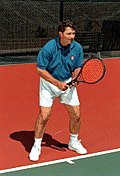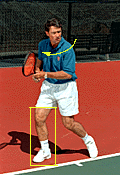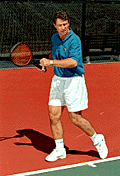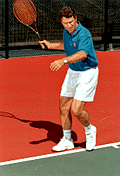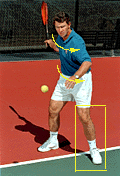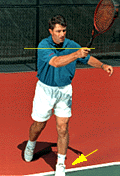|
TennisOne Lessons


The Basics of the Forehand Drive
by Jim McLennan
Coming Against the Ball
The forehand is the breakthrough stroke of champions, Sampras and Agassi today, and before them Borg, Kramer and Perry. Whether hit flat or with topspin, either an eastern or semi-Western grip, all these great champions hit their forehands incorporating certain basic elements. To visualize these basic elements, take a moment to check out the Dynamics of Throwing A Ball lesson in the TennisONE lesson library. You will see the throwing and forehand motions have remarkably similar movements and body dynamics. First, the hips and shoulders turn as bringing the hands come together. Then comes the unweighting of the forward foot and the coiling of the knee as the body pivots. The hands split as the throwing arm or racquet arm extends back. Finally, in both the throwing and forehand motion, the weight is transferred to the forward foot, and then comes the progressive and linked uncoiling of the hips, shoulders, arm and wrist. The forehand described in this basic lesson is simply a drive, neither using extreme topspin or backspin, but rather what I call, just "coming against the ball."
In the first photo in the sequence below, I've assume the ready position. (see Basynat's Preparing Racquet Early for more detail). It's a simple posture: my weight is evenly distributed on both legs, my knees and elbows are slightly bent, and I should have a look that reflects a heightened sense of alertness, but also a calm, positive attitude.
Ask a tennis friend, "What exactly do you do in the ready position?" As you'll see by the stunned look of bewilderment, it's not an easy question to answer. The correct answer is that I'm waiting to read the ball, and ready to move and turn.
In the middle photo of the sequence below, having read a forehand return, all I've done is turn my hips and shoulders. I'm ready to hit or run. My hands are unchanged, but notice my left knee, which is now unweighted. Were I to run, I would lead with this foot. Were I to step and swing, with this unweighted foot I would be able to transfer my weight into the shot. Look at the top club players as they turn and prepare for their shots-you'll see that front foot unweighted.
In the final photo below, I'm turning more, coiling my hips and shoulders more fully. My hands are also beginning to move apart as I move into my full backswing motion. Notice that I've unweighted my front foot even more. From this position, I'm almost prepared to start my forward movement and come up against the ball..
Hitting Heavy
In the first photo below, I'm just starting to move forward and swing. My weight is still predominantly on my back foot. My hands are beginning to split as my left arm begins to swing forward simultaneous with my step into the ball. In a natural rhythm, the left hand and foot are "together ," moving in synch into the swing.
In the middle photo below, I have shifted my weight onto the left foot as I reach the end of my backswing. This is very important to maintaining rhythm and balance. The backswing must be completed at this moment and not an instant before (in other words, my weight has actually shifted to my front foot before my hips and shoulders rotate). Players should not run to hit the ball with their racquet arms extended back. Nor should there be a hitch or glaring pause between the backswing and the forward stroke. Rather, the player should have a dynamic backswing, meaning that the racquet moves back and then forward in a continuous, rhythmic motion. After I've transferred my weight to my front foot, by hips and then my shoulders begin to uncoil. Just as in the throwing-a-ball motion described in an earlier lesson, I'm moving forward but the key to my power is the angular momentum (turning energy) of my hips and shoulders . This is how the great champions generate the power to make their forehands into a breakthrough weapon.
In the final photo, note that on my follow-through my shoulders have turned fully into the ball and my weight is totally on my front foot. If you think back to the previous sequence where my body is turned and weight is on my back foot, you can get a clear idea of how to pivot, step forward, and come up against the ball. You will be hitting heavy and your opponents will be on their heels.
Your comments are welcome. Let us know what you think about Jim McLennan's article by emailing us here at TennisONE.

|

|
The Secrets of World Class Footwork - Featuring
Stefan Edberg
by Jim McLennan
Learn the secret to the quickest start to the ball, and the secret
to effortless movement about the court.
Includes footage of
Stefan Edberg, one of the quickest and most graceful of all the
professionals.
|

|
|
Learn pattern movements to the volleys, groundstrokes, and
split step reactions. Rehearse explosive starts, gliding movements,
and build your aerobic endurance. If you are serious about improving your tennis,
footwork is the key.
Includes video tape and training manual (pictured above). - $29.95
plus 2.50 shipping and handling
|
|
|

